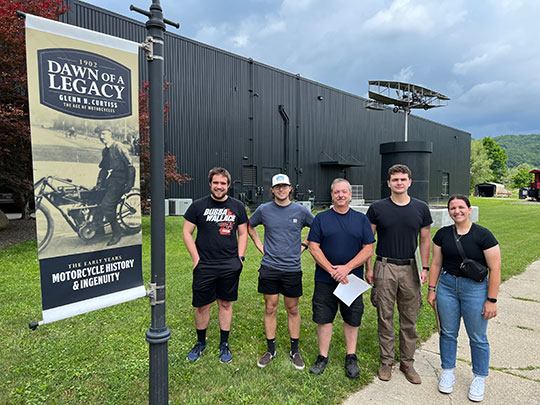Alfred University mechanical engineering students tour Glenn H. Curtiss Museum

A group of mechanical engineering students from Alfred University recently visited the Glenn H. Curtiss Museum in Hammondsport, NY, where they learned about the pioneering aviator who helped found the U.S. aircraft industry.
Students Jordan Fixsen, Abby Gatza, Evan Kent, Lucas Young—accompanied by Jim Mighells, technician and machinist in the mechanical engineering department—participated in the day trip to the museum on July 7, The students are participating in the summer mechanical engineering internship program, which is supported by Alfred University’s Center for Advanced Ceramic Technology (CACT).
The group toured the facility for three hours and learned about the role Curtiss played in the development of many modern means of transportation, including bicycles, motorcycles, and airplanes.
A native of Hammondsport, Curtiss raced bicycles before turning his interest to motorcycles. In 1902, at the age of 26, he developed and manufactured a single-cylinder engines motorcycle, setting a motorcycle land speed record (64 miles per hour) a year later. In 1907, on an eight-cylinder engine motorcycle he designed and built, Curtiss set a new land speed record of 136 MPH, a mark that held up until 1930. That motorcycle is displayed in the Smithsonian Institution.
His design and construction of aircraft led to the formation of the Curtiss Aeroplane and Motor Company, which later merged into the Curtiss-Wright Corporation. The company constructed aircraft for the U.S. Army and Navy, and, during the years leading up to World War I, his experiments with seaplanes led to advances in naval aviation.
In their tour of the museum, students took in historical exhibits showcasing Curtiss’ contributions to the development of various modern means of transportation, and the impact his inventions had on the course of history.
The summer interns have been working on innovative engineering projects that showcase their technical prowess and commitment to sustainability.
One such project is the construction of an innovative plastic shredder and extruder, a piece of equipment critical to developing new uses for recycled plastic. This sustainable initiative aims to transform waste plastic into valuable materials, contributing to the global efforts of recycling and waste reduction. The shredder breaks down incoming plastic into smaller fragments, which are then melted and conveyed through a heated tube by an auger. The resulting molten plastic is channeled to a die, where it can be formed into various shapes, opening up possibilities for further applications of recycled plastic materials.
The interns are also involved in the development of a Split Hopkinson Pressure Bar (SHPB), an apparatus designed for testing the dynamic stress-strain response of materials. This state-of-the-art equipment will play a crucial role in the study of materials used in hypersonic vehicles, supporting advancements in aerospace technology, and ensuring safety and reliability in extreme conditions.
